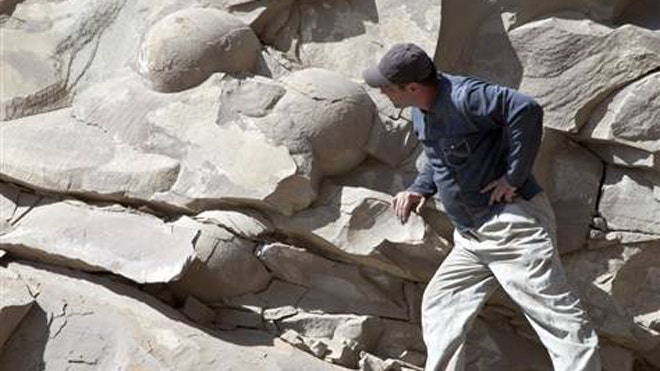They found a tooth of a giant carnivore not far from the fossil, yet there is no evidence so far to suggest that the two creatures' deaths are interlinked. 'We hope the future excavation will help unveil more evidence to suggest what caused the death of this mammoth creature,' Sun told China's state-run Xinhua News Agency.
Yet thousands of kilometres away in the politically volatile Chechnya Region of Russia, other giant discoveries were made. Once part of the Soviet empire and bordering with the Caucasus Mountains, the area has been a hotbed for everything from communist to Islamic territorial wars. Yet in recent years political stability has allowed a tourist industry to grow.
Yet thousands of kilometres away in the politically volatile Chechnya Region of Russia, other giant discoveries were made. Once part of the Soviet empire and bordering with the Caucasus Mountains, the area has been a hotbed for everything from communist to Islamic territorial wars. Yet in recent years political stability has allowed a tourist industry to grow.
 |
| The giant dinosaur eggs from the Chechnya Region, Russia |
40 or so have been uncovered, but more may be revealed. While the parent dinosaurs have not been found or identified, the eggs are larger than any previously recovered from places such as the Gobi Desert. You may be asking yourself what these two discoveries have to do with each other?
A recent study has suggested that the beginning of the end for the dinosaurs was down to size. Dinosaur eggs incorporate a porous membrane which allows oxygen to reach the embryo. The problem is that the larger the embryo, the larger the egg needs to be and therefore the thicker the shell in order to support its structure. Eventually oxygen will be unable to reach the developing creature. This puts a limit on how large the eggs, and the newly hatched animal, can be in relation to its parent.
The African elephant calf is 22 times smaller than the adult, but dinosaurs could be thousands of times smaller. As a result a dinosaur family could not occupy the same territory, and the young would seek out new pastures. This competition from giant species meant that there was a lack of diversity in the smaller bodied creatures. In order to survive, they were forced to find new ecological niches: birds, for example, took to the air.
When the Earth was struck by an asteroid 65 million years ago, the larger creatures starved due to the destruction of their food sources. The newly opened ecological niches were filled by small mammals and birds less than 10 kilograms in weight. Yet the dinosaurs were unable to make such a return due to a lack of small species which could survive the food and climate crisis, or adapt fast enough to new habitats.
A recent study has suggested that the beginning of the end for the dinosaurs was down to size. Dinosaur eggs incorporate a porous membrane which allows oxygen to reach the embryo. The problem is that the larger the embryo, the larger the egg needs to be and therefore the thicker the shell in order to support its structure. Eventually oxygen will be unable to reach the developing creature. This puts a limit on how large the eggs, and the newly hatched animal, can be in relation to its parent.
The African elephant calf is 22 times smaller than the adult, but dinosaurs could be thousands of times smaller. As a result a dinosaur family could not occupy the same territory, and the young would seek out new pastures. This competition from giant species meant that there was a lack of diversity in the smaller bodied creatures. In order to survive, they were forced to find new ecological niches: birds, for example, took to the air.
When the Earth was struck by an asteroid 65 million years ago, the larger creatures starved due to the destruction of their food sources. The newly opened ecological niches were filled by small mammals and birds less than 10 kilograms in weight. Yet the dinosaurs were unable to make such a return due to a lack of small species which could survive the food and climate crisis, or adapt fast enough to new habitats.